2007 ISUZU KB P190 turn signal
[x] Cancel search: turn signalPage 1717 of 6020
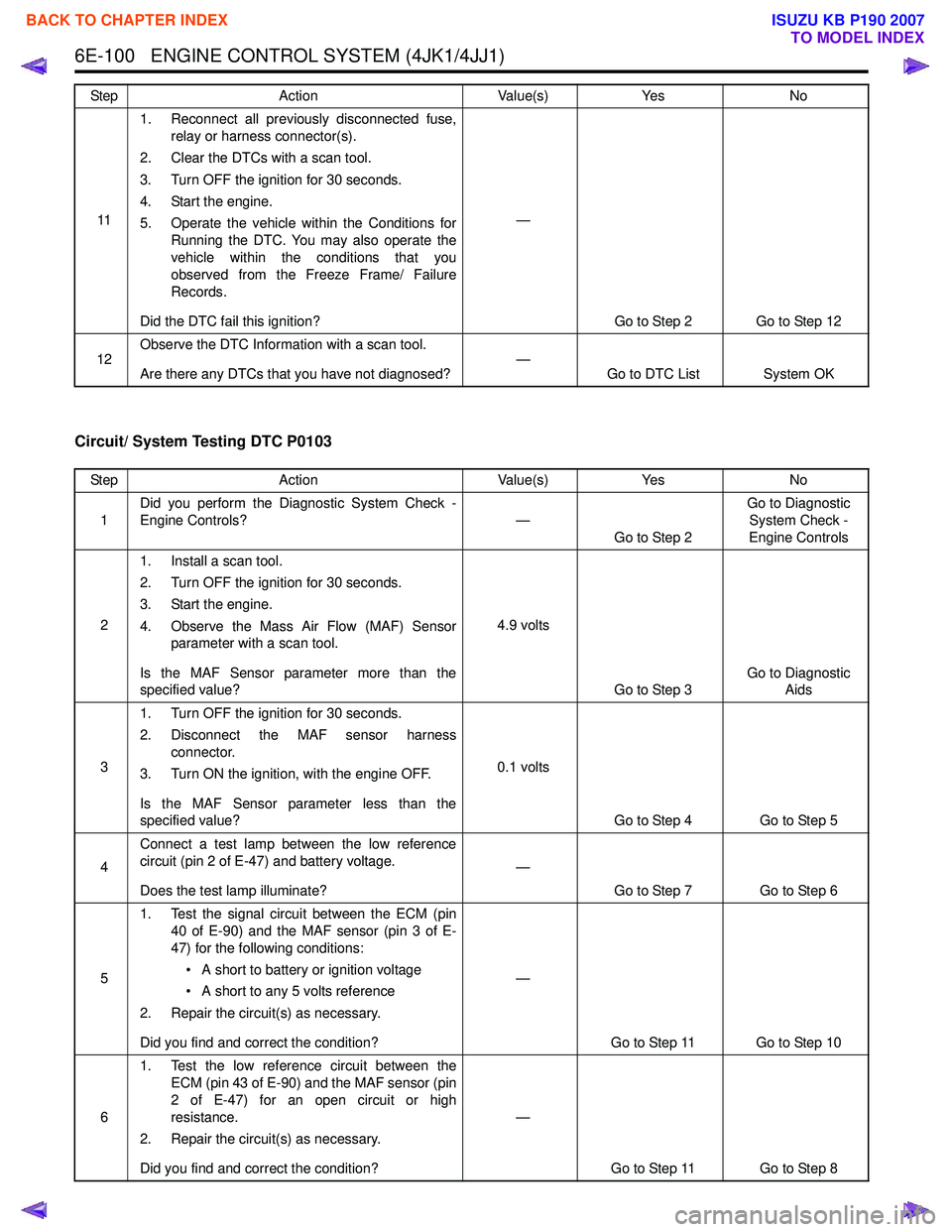
6E-100 ENGINE CONTROL SYSTEM (4JK1/4JJ1)
Circuit/ System Testing DTC P0103
111. Reconnect all previously disconnected fuse,
relay or harness connector(s).
2. Clear the DTCs with a scan tool.
3. Turn OFF the ignition for 30 seconds.
4. Start the engine.
5. Operate the vehicle within the Conditions for Running the DTC. You may also operate the
vehicle within the conditions that you
observed from the Freeze Frame/ Failure
Records.
Did the DTC fail this ignition? —
Go to Step 2 Go to Step 12
12 Observe the DTC Information with a scan tool.
Are there any DTCs that you have not diagnosed? —
Go to DTC List System OK
Step
Action Value(s)Yes No
Step Action Value(s)Yes No
1 Did you perform the Diagnostic System Check -
Engine Controls? —
Go to Step 2 Go to Diagnostic
System Check -
Engine Controls
2 1. Install a scan tool.
2. Turn OFF the ignition for 30 seconds.
3. Start the engine.
4. Observe the Mass Air Flow (MAF) Sensor parameter with a scan tool.
Is the MAF Sensor parameter more than the
specified value? 4.9 volts
Go to Step 3 Go to Diagnostic
Aids
3 1. Turn OFF the ignition for 30 seconds.
2. Disconnect the MAF sensor harness connector.
3. Turn ON the ignition, with the engine OFF.
Is the MAF Sensor parameter less than the
specified value? 0.1 volts
Go to Step 4 Go to Step 5
4 Connect a test lamp between the low reference
circuit (pin 2 of E-47) and battery voltage.
Does the test lamp illuminate? —
Go to Step 7 Go to Step 6
5 1. Test the signal circuit between the ECM (pin
40 of E-90) and the MAF sensor (pin 3 of E-
47) for the following conditions:
• A short to battery or ignition voltage
• A short to any 5 volts reference
2. Repair the circuit(s) as necessary.
Did you find and correct the condition? —
Go to Step 11 Go to Step 10
6 1. Test the low reference circuit between the
ECM (pin 43 of E-90) and the MAF sensor (pin
2 of E-47) for an open circuit or high
resistance.
2. Repair the circuit(s) as necessary.
Did you find and correct the condition? —
Go to Step 11 Go to Step 8
BACK TO CHAPTER INDEX
TO MODEL INDEX
ISUZU KB P190 2007
Page 1719 of 6020
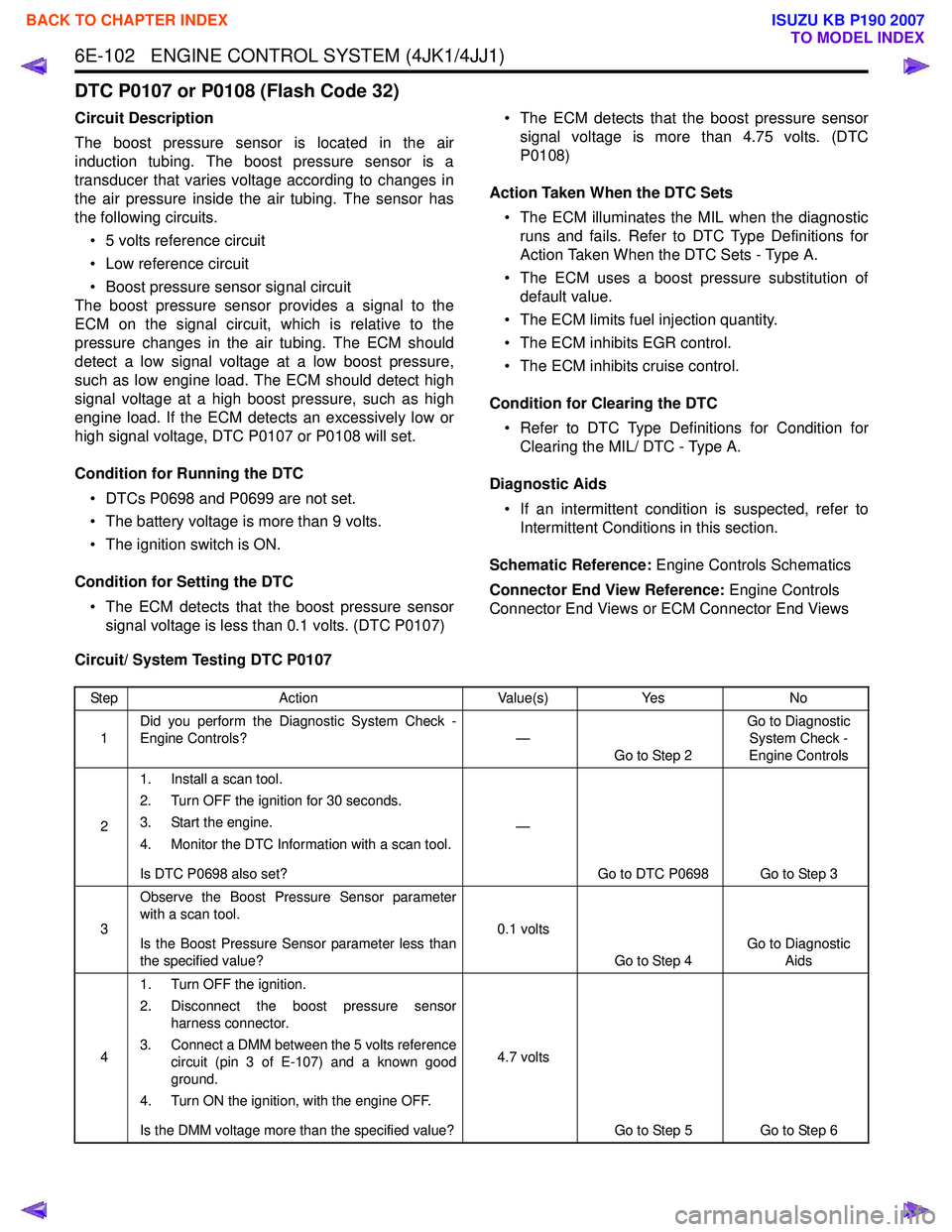
6E-102 ENGINE CONTROL SYSTEM (4JK1/4JJ1)
DTC P0107 or P0108 (Flash Code 32)
Circuit Description
The boost pressure sensor is located in the air
induction tubing. The boost pressure sensor is a
transducer that varies voltage according to changes in
the air pressure inside the air tubing. The sensor has
the following circuits.
• 5 volts reference circuit
• Low reference circuit
• Boost pressure sensor signal circuit
The boost pressure sensor provides a signal to the
ECM on the signal circuit, which is relative to the
pressure changes in the air tubing. The ECM should
detect a low signal voltage at a low boost pressure,
such as low engine load. The ECM should detect high
signal voltage at a high boost pressure, such as high
engine load. If the ECM detects an excessively low or
high signal voltage, DTC P0107 or P0108 will set.
Condition for Running the DTC • DTCs P0698 and P0699 are not set.
• The battery voltage is more than 9 volts.
• The ignition switch is ON.
Condition for Setting the DTC • The ECM detects that the boost pressure sensor signal voltage is less than 0.1 volts. (DTC P0107) • The ECM detects that the boost pressure sensor
signal voltage is more than 4.75 volts. (DTC
P0108)
Action Taken When the DTC Sets • The ECM illuminates the MIL when the diagnostic runs and fails. Refer to DTC Type Definitions for
Action Taken When the DTC Sets - Type A.
• The ECM uses a boost pressure substitution of default value.
• The ECM limits fuel injection quantity.
• The ECM inhibits EGR control.
• The ECM inhibits cruise control.
Condition for Clearing the DTC • Refer to DTC Type Definitions for Condition for Clearing the MIL/ DTC - Type A.
Diagnostic Aids • If an intermittent condition is suspected, refer to Intermittent Conditions in this section.
Schematic Reference: Engine Controls Schematics
Connector End View Reference: Engine Controls
Connector End Views or ECM Connector End Views
Circuit/ System Testing DTC P0107
Step Action Value(s)Yes No
1 Did you perform the Diagnostic System Check -
Engine Controls? —
Go to Step 2 Go to Diagnostic
System Check -
Engine Controls
2 1. Install a scan tool.
2. Turn OFF the ignition for 30 seconds.
3. Start the engine.
4. Monitor the DTC Information with a scan tool.
Is DTC P0698 also set? —
Go to DTC P0698 Go to Step 3
3 Observe the Boost Pressure Sensor parameter
with a scan tool.
Is the Boost Pressure Sensor parameter less than
the specified value? 0.1 volts
Go to Step 4 Go to Diagnostic
Aids
4 1. Turn OFF the ignition.
2. Disconnect the boost pressure sensor harness connector.
3. Connect a DMM between the 5 volts reference circuit (pin 3 of E-107) and a known good
ground.
4. Turn ON the ignition, with the engine OFF.
Is the DMM voltage more than the specified value? 4.7 volts
Go to Step 5 Go to Step 6
BACK TO CHAPTER INDEX
TO MODEL INDEX
ISUZU KB P190 2007
Page 1720 of 6020
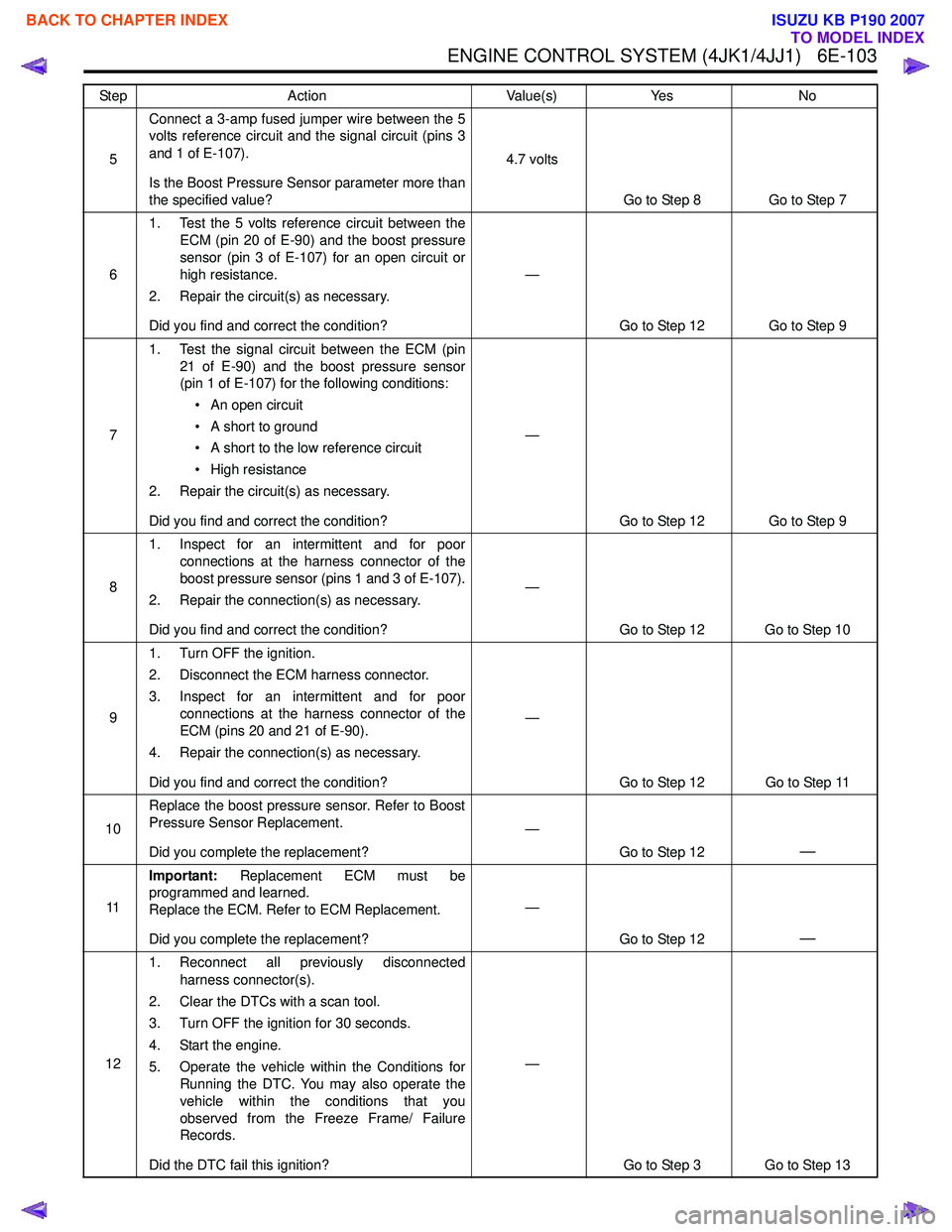
ENGINE CONTROL SYSTEM (4JK1/4JJ1) 6E-103
5Connect a 3-amp fused jumper wire between the 5
volts reference circuit and the signal circuit (pins 3
and 1 of E-107).
Is the Boost Pressure Sensor parameter more than
the specified value? 4.7 volts
Go to Step 8 Go to Step 7
6 1. Test the 5 volts reference circuit between the
ECM (pin 20 of E-90) and the boost pressure
sensor (pin 3 of E-107) for an open circuit or
high resistance.
2. Repair the circuit(s) as necessary.
Did you find and correct the condition? —
Go to Step 12 Go to Step 9
7 1. Test the signal circuit between the ECM (pin
21 of E-90) and the boost pressure sensor
(pin 1 of E-107) for the following conditions:
• An open circuit
• A short to ground
• A short to the low reference circuit
• High resistance
2. Repair the circuit(s) as necessary.
Did you find and correct the condition? —
Go to Step 12 Go to Step 9
8 1. Inspect for an intermittent and for poor
connections at the harness connector of the
boost pressure sensor (pins 1 and 3 of E-107).
2. Repair the connection(s) as necessary.
Did you find and correct the condition? —
Go to Step 12 Go to Step 10
9 1. Turn OFF the ignition.
2. Disconnect the ECM harness connector.
3. Inspect for an intermittent and for poor connections at the harness connector of the
ECM (pins 20 and 21 of E-90).
4. Repair the connection(s) as necessary.
Did you find and correct the condition? —
Go to Step 12 Go to Step 11
10 Replace the boost pressure sensor. Refer to Boost
Pressure Sensor Replacement.
Did you complete the replacement? —
Go to Step 12
—
11Important:
Replacement ECM must be
programmed and learned.
Replace the ECM. Refer to ECM Replacement.
Did you complete the replacement? —
Go to Step 12
—
121. Reconnect all previously disconnected
harness connector(s).
2. Clear the DTCs with a scan tool.
3. Turn OFF the ignition for 30 seconds.
4. Start the engine.
5. Operate the vehicle within the Conditions for Running the DTC. You may also operate the
vehicle within the conditions that you
observed from the Freeze Frame/ Failure
Records.
Did the DTC fail this ignition? —
Go to Step 3 Go to Step 13
Step
Action Value(s)Yes No
BACK TO CHAPTER INDEX
TO MODEL INDEX
ISUZU KB P190 2007
Page 1721 of 6020
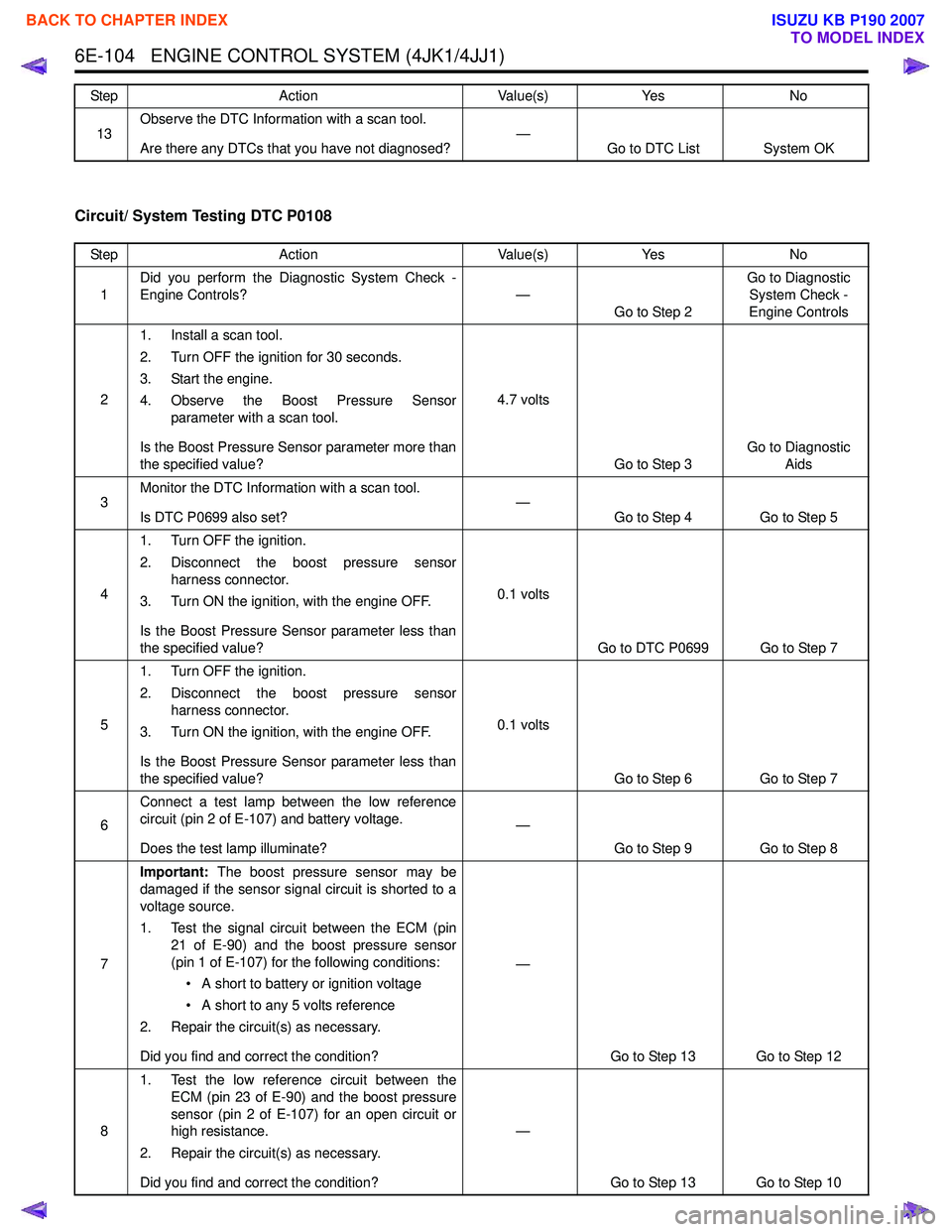
6E-104 ENGINE CONTROL SYSTEM (4JK1/4JJ1)
Circuit/ System Testing DTC P0108
13Observe the DTC Information with a scan tool.
Are there any DTCs that you have not diagnosed? —
Go to DTC List System OK
Step
Action Value(s)Yes No
Step Action Value(s)Yes No
1 Did you perform the Diagnostic System Check -
Engine Controls? —
Go to Step 2 Go to Diagnostic
System Check -
Engine Controls
2 1. Install a scan tool.
2. Turn OFF the ignition for 30 seconds.
3. Start the engine.
4. Observe the Boost Pressure Sensor parameter with a scan tool.
Is the Boost Pressure Sensor parameter more than
the specified value? 4.7 volts
Go to Step 3 Go to Diagnostic
Aids
3 Monitor the DTC Information with a scan tool.
Is DTC P0699 also set? —
Go to Step 4 Go to Step 5
4 1. Turn OFF the ignition.
2. Disconnect the boost pressure sensor harness connector.
3. Turn ON the ignition, with the engine OFF.
Is the Boost Pressure Sensor parameter less than
the specified value? 0.1 volts
Go to DTC P0699 Go to Step 7
5 1. Turn OFF the ignition.
2. Disconnect the boost pressure sensor harness connector.
3. Turn ON the ignition, with the engine OFF.
Is the Boost Pressure Sensor parameter less than
the specified value? 0.1 volts
Go to Step 6 Go to Step 7
6 Connect a test lamp between the low reference
circuit (pin 2 of E-107) and battery voltage.
Does the test lamp illuminate? —
Go to Step 9 Go to Step 8
7 Important:
The boost pressure sensor may be
damaged if the sensor signal circuit is shorted to a
voltage source.
1. Test the signal circuit between the ECM (pin 21 of E-90) and the boost pressure sensor
(pin 1 of E-107) for the following conditions:
• A short to battery or ignition voltage
• A short to any 5 volts reference
2. Repair the circuit(s) as necessary.
Did you find and correct the condition? —
Go to Step 13 Go to Step 12
8 1. Test the low reference circuit between the
ECM (pin 23 of E-90) and the boost pressure
sensor (pin 2 of E-107) for an open circuit or
high resistance.
2. Repair the circuit(s) as necessary.
Did you find and correct the condition? —
Go to Step 13 Go to Step 10
BACK TO CHAPTER INDEX
TO MODEL INDEX
ISUZU KB P190 2007
Page 1723 of 6020
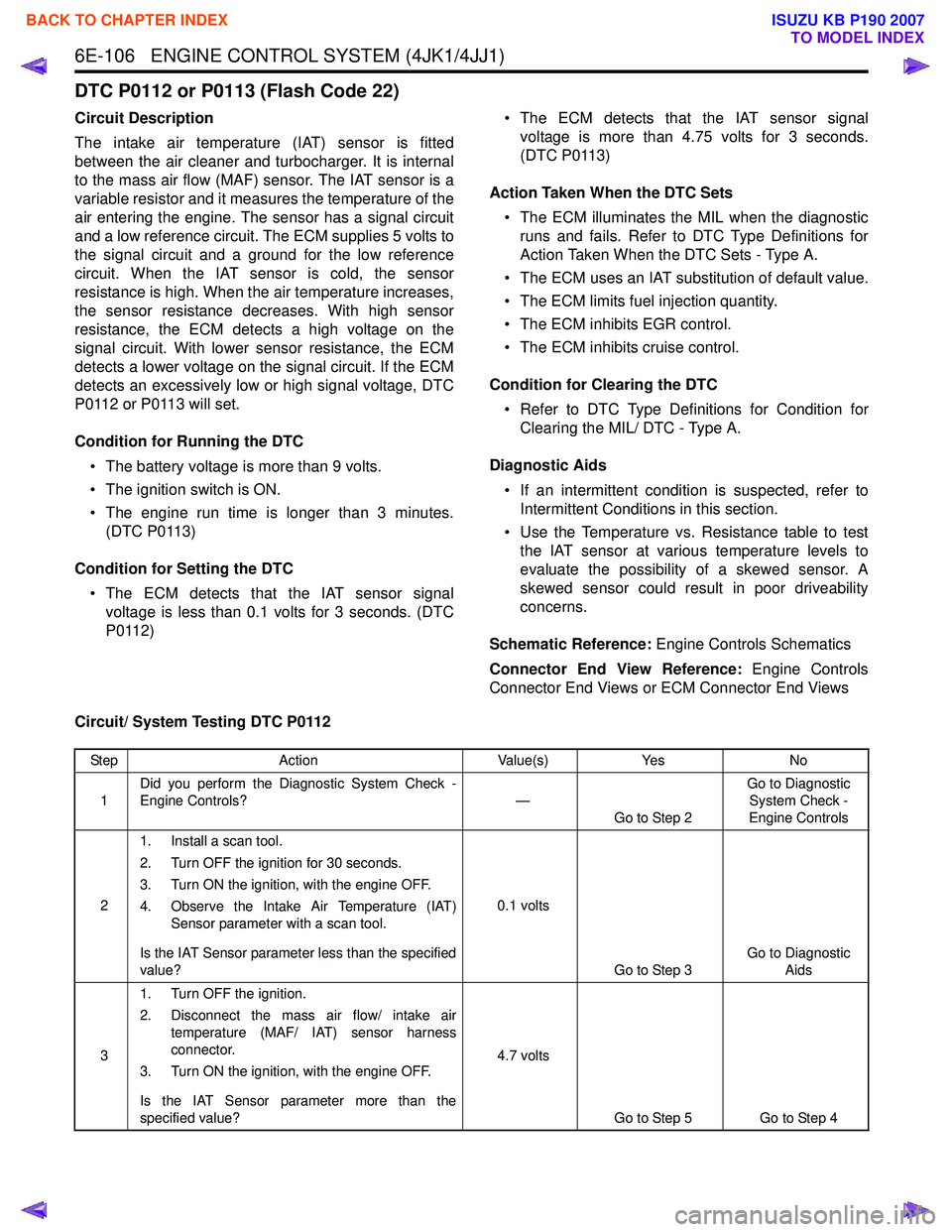
6E-106 ENGINE CONTROL SYSTEM (4JK1/4JJ1)
DTC P0112 or P0113 (Flash Code 22)
Circuit Description
The intake air temperature (IAT) sensor is fitted
between the air cleaner and turbocharger. It is internal
to the mass air flow (MAF) sensor. The IAT sensor is a
variable resistor and it measures the temperature of the
air entering the engine. The sensor has a signal circuit
and a low reference circuit. The ECM supplies 5 volts to
the signal circuit and a ground for the low reference
circuit. When the IAT sensor is cold, the sensor
resistance is high. When the air temperature increases,
the sensor resistance decreases. With high sensor
resistance, the ECM detects a high voltage on the
signal circuit. With lower sensor resistance, the ECM
detects a lower voltage on the signal circuit. If the ECM
detects an excessively low or high signal voltage, DTC
P0112 or P0113 will set.
Condition for Running the DTC • The battery voltage is more than 9 volts.
• The ignition switch is ON.
• The engine run time is longer than 3 minutes. (DTC P0113)
Condition for Setting the DTC • The ECM detects that the IAT sensor signal voltage is less than 0.1 volts for 3 seconds. (DTC
P0112) • The ECM detects that the IAT sensor signal
voltage is more than 4.75 volts for 3 seconds.
(DTC P0113)
Action Taken When the DTC Sets • The ECM illuminates the MIL when the diagnostic runs and fails. Refer to DTC Type Definitions for
Action Taken When the DTC Sets - Type A.
• The ECM uses an IAT substitution of default value.
• The ECM limits fuel injection quantity.
• The ECM inhibits EGR control.
• The ECM inhibits cruise control.
Condition for Clearing the DTC • Refer to DTC Type Definitions for Condition for Clearing the MIL/ DTC - Type A.
Diagnostic Aids • If an intermittent condition is suspected, refer to Intermittent Conditions in this section.
• Use the Temperature vs. Resistance table to test the IAT sensor at various temperature levels to
evaluate the possibility of a skewed sensor. A
skewed sensor could result in poor driveability
concerns.
Schematic Reference: Engine Controls Schematics
Connector End View Reference: Engine Controls
Connector End Views or ECM Connector End Views
Circuit/ System Testing DTC P0112
Step Action Value(s)Yes No
1 Did you perform the Diagnostic System Check -
Engine Controls? —
Go to Step 2 Go to Diagnostic
System Check -
Engine Controls
2 1. Install a scan tool.
2. Turn OFF the ignition for 30 seconds.
3. Turn ON the ignition, with the engine OFF.
4. Observe the Intake Air Temperature (IAT) Sensor parameter with a scan tool.
Is the IAT Sensor parameter less than the specified
value? 0.1 volts
Go to Step 3 Go to Diagnostic
Aids
3 1. Turn OFF the ignition.
2. Disconnect the mass air flow/ intake air temperature (MAF/ IAT) sensor harness
connector.
3. Turn ON the ignition, with the engine OFF.
Is the IAT Sensor parameter more than the
specified value? 4.7 volts
Go to Step 5 Go to Step 4
BACK TO CHAPTER INDEX
TO MODEL INDEX
ISUZU KB P190 2007
Page 1724 of 6020
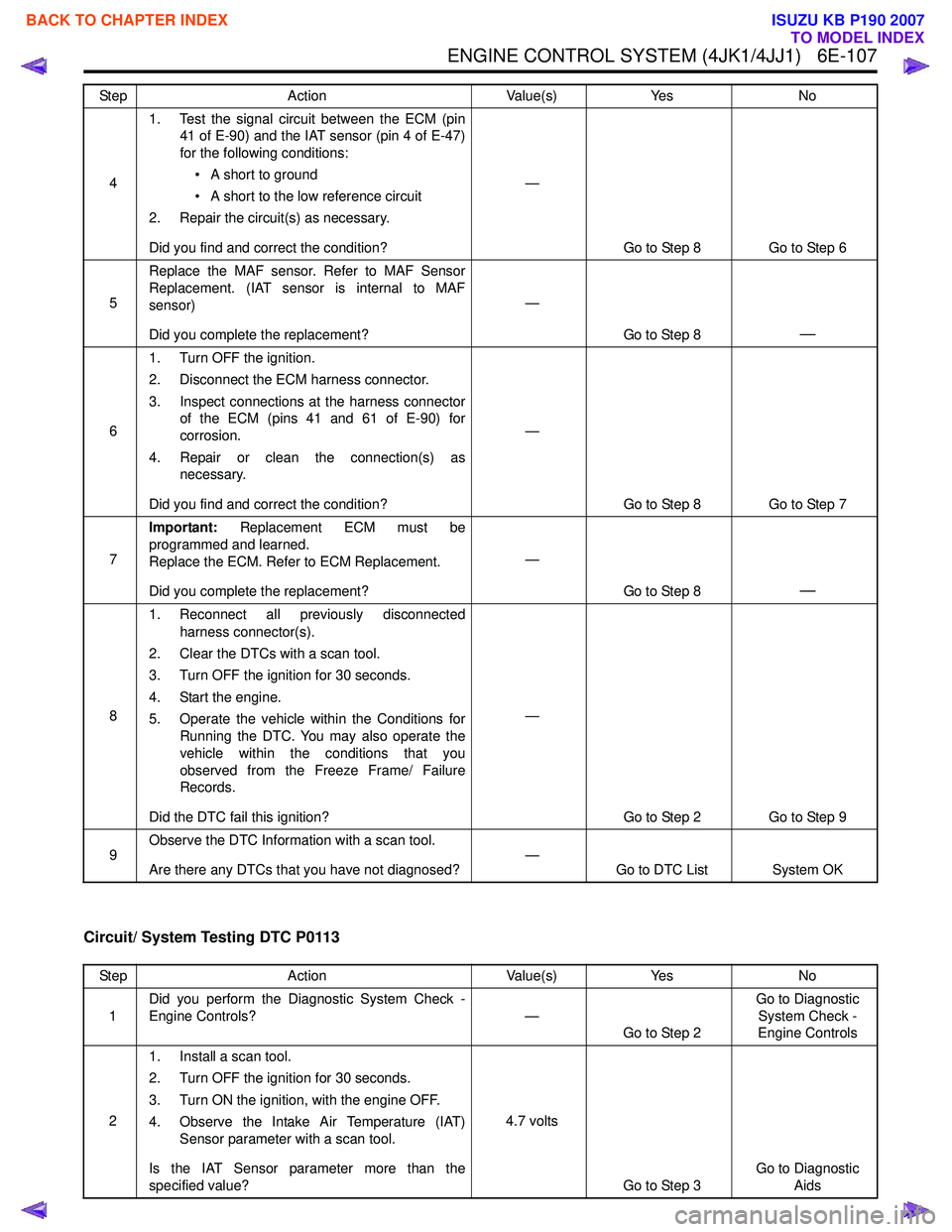
ENGINE CONTROL SYSTEM (4JK1/4JJ1) 6E-107
Circuit/ System Testing DTC P0113
41. Test the signal circuit between the ECM (pin
41 of E-90) and the IAT sensor (pin 4 of E-47)
for the following conditions:
• A short to ground
• A short to the low reference circuit
2. Repair the circuit(s) as necessary.
Did you find and correct the condition? —
Go to Step 8 Go to Step 6
5 Replace the MAF sensor. Refer to MAF Sensor
Replacement. (IAT sensor is internal to MAF
sensor)
Did you complete the replacement? —
Go to Step 8
—
61. Turn OFF the ignition.
2. Disconnect the ECM harness connector.
3. Inspect connections at the harness connector of the ECM (pins 41 and 61 of E-90) for
corrosion.
4. Repair or clean the connection(s) as necessary.
Did you find and correct the condition? —
Go to Step 8 Go to Step 7
7 Important:
Replacement ECM must be
programmed and learned.
Replace the ECM. Refer to ECM Replacement.
Did you complete the replacement? —
Go to Step 8
—
81. Reconnect all previously disconnected
harness connector(s).
2. Clear the DTCs with a scan tool.
3. Turn OFF the ignition for 30 seconds.
4. Start the engine.
5. Operate the vehicle within the Conditions for Running the DTC. You may also operate the
vehicle within the conditions that you
observed from the Freeze Frame/ Failure
Records.
Did the DTC fail this ignition? —
Go to Step 2 Go to Step 9
9 Observe the DTC Information with a scan tool.
Are there any DTCs that you have not diagnosed? —
Go to DTC List System OK
Step
Action Value(s)Yes No
Step Action Value(s)Yes No
1 Did you perform the Diagnostic System Check -
Engine Controls? —
Go to Step 2 Go to Diagnostic
System Check -
Engine Controls
2 1. Install a scan tool.
2. Turn OFF the ignition for 30 seconds.
3. Turn ON the ignition, with the engine OFF.
4. Observe the Intake Air Temperature (IAT) Sensor parameter with a scan tool.
Is the IAT Sensor parameter more than the
specified value? 4.7 volts
Go to Step 3 Go to Diagnostic
Aids
BACK TO CHAPTER INDEX
TO MODEL INDEX
ISUZU KB P190 2007
Page 1725 of 6020
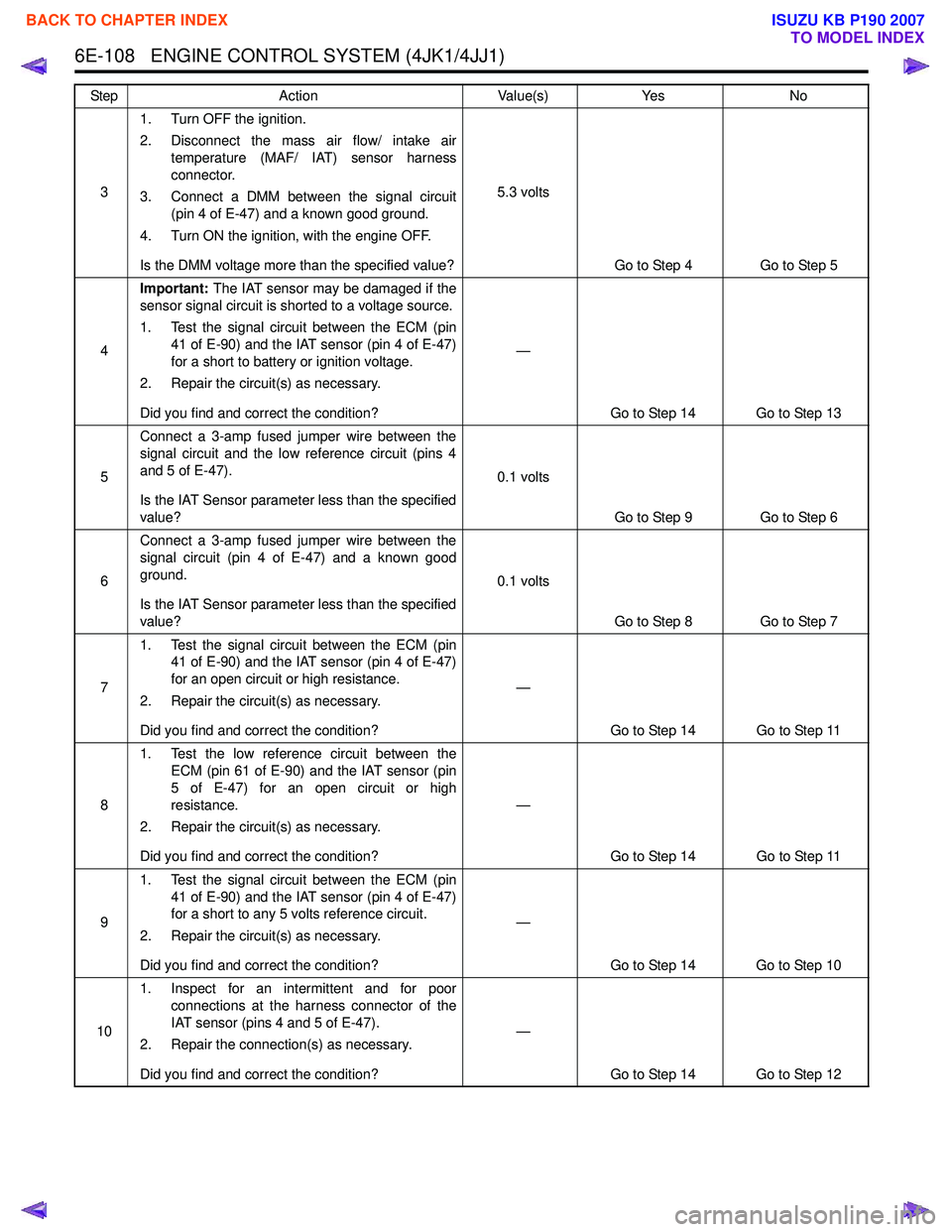
6E-108 ENGINE CONTROL SYSTEM (4JK1/4JJ1)
31. Turn OFF the ignition.
2. Disconnect the mass air flow/ intake air temperature (MAF/ IAT) sensor harness
connector.
3. Connect a DMM between the signal circuit (pin 4 of E-47) and a known good ground.
4. Turn ON the ignition, with the engine OFF.
Is the DMM voltage more than the specified value? 5.3 volts
Go to Step 4 Go to Step 5
4 Important:
The IAT sensor may be damaged if the
sensor signal circuit is shorted to a voltage source.
1. Test the signal circuit between the ECM (pin 41 of E-90) and the IAT sensor (pin 4 of E-47)
for a short to battery or ignition voltage.
2. Repair the circuit(s) as necessary.
Did you find and correct the condition? —
Go to Step 14 Go to Step 13
5 Connect a 3-amp fused jumper wire between the
signal circuit and the low reference circuit (pins 4
and 5 of E-47).
Is the IAT Sensor parameter less than the specified
value? 0.1 volts
Go to Step 9 Go to Step 6
6 Connect a 3-amp fused jumper wire between the
signal circuit (pin 4 of E-47) and a known good
ground.
Is the IAT Sensor parameter less than the specified
value? 0.1 volts
Go to Step 8 Go to Step 7
7 1. Test the signal circuit between the ECM (pin
41 of E-90) and the IAT sensor (pin 4 of E-47)
for an open circuit or high resistance.
2. Repair the circuit(s) as necessary.
Did you find and correct the condition? —
Go to Step 14 Go to Step 11
8 1. Test the low reference circuit between the
ECM (pin 61 of E-90) and the IAT sensor (pin
5 of E-47) for an open circuit or high
resistance.
2. Repair the circuit(s) as necessary.
Did you find and correct the condition? —
Go to Step 14 Go to Step 11
9 1. Test the signal circuit between the ECM (pin
41 of E-90) and the IAT sensor (pin 4 of E-47)
for a short to any 5 volts reference circuit.
2. Repair the circuit(s) as necessary.
Did you find and correct the condition? —
Go to Step 14 Go to Step 10
10 1. Inspect for an intermittent and for poor
connections at the harness connector of the
IAT sensor (pins 4 and 5 of E-47).
2. Repair the connection(s) as necessary.
Did you find and correct the condition? —
Go to Step 14 Go to Step 12
Step
Action Value(s)Yes No
BACK TO CHAPTER INDEX
TO MODEL INDEX
ISUZU KB P190 2007
Page 1729 of 6020
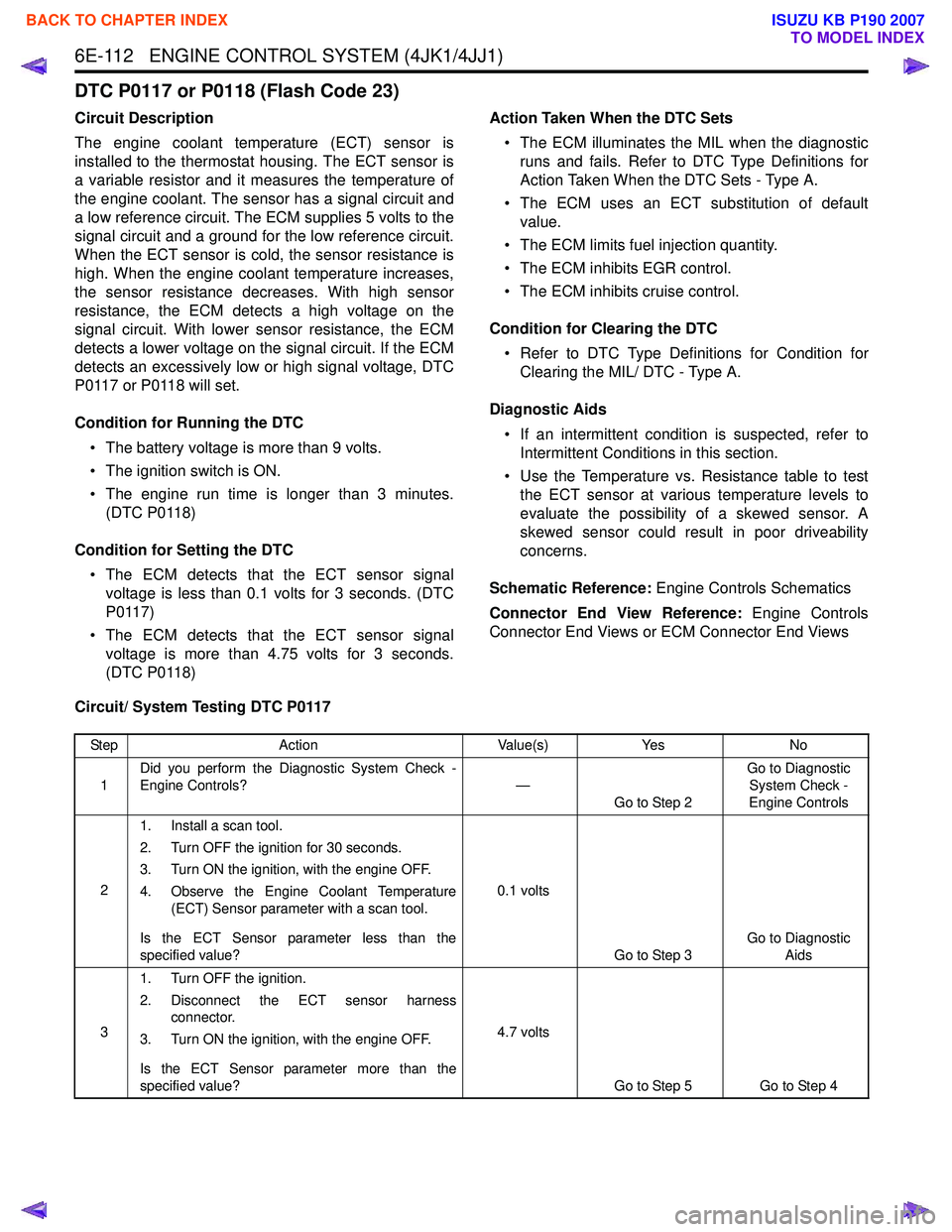
6E-112 ENGINE CONTROL SYSTEM (4JK1/4JJ1)
DTC P0117 or P0118 (Flash Code 23)
Circuit Description
The engine coolant temperature (ECT) sensor is
installed to the thermostat housing. The ECT sensor is
a variable resistor and it measures the temperature of
the engine coolant. The sensor has a signal circuit and
a low reference circuit. The ECM supplies 5 volts to the
signal circuit and a ground for the low reference circuit.
When the ECT sensor is cold, the sensor resistance is
high. When the engine coolant temperature increases,
the sensor resistance decreases. With high sensor
resistance, the ECM detects a high voltage on the
signal circuit. With lower sensor resistance, the ECM
detects a lower voltage on the signal circuit. If the ECM
detects an excessively low or high signal voltage, DTC
P0117 or P0118 will set.
Condition for Running the DTC • The battery voltage is more than 9 volts.
• The ignition switch is ON.
• The engine run time is longer than 3 minutes. (DTC P0118)
Condition for Setting the DTC • The ECM detects that the ECT sensor signal voltage is less than 0.1 volts for 3 seconds. (DTC
P0117)
• The ECM detects that the ECT sensor signal voltage is more than 4.75 volts for 3 seconds.
(DTC P0118) Action Taken When the DTC Sets
• The ECM illuminates the MIL when the diagnostic runs and fails. Refer to DTC Type Definitions for
Action Taken When the DTC Sets - Type A.
• The ECM uses an ECT substitution of default value.
• The ECM limits fuel injection quantity.
• The ECM inhibits EGR control.
• The ECM inhibits cruise control.
Condition for Clearing the DTC • Refer to DTC Type Definitions for Condition for Clearing the MIL/ DTC - Type A.
Diagnostic Aids • If an intermittent condition is suspected, refer to Intermittent Conditions in this section.
• Use the Temperature vs. Resistance table to test the ECT sensor at various temperature levels to
evaluate the possibility of a skewed sensor. A
skewed sensor could result in poor driveability
concerns.
Schematic Reference: Engine Controls Schematics
Connector End View Reference: Engine Controls
Connector End Views or ECM Connector End Views
Circuit/ System Testing DTC P0117
Step Action Value(s)Yes No
1 Did you perform the Diagnostic System Check -
Engine Controls? —
Go to Step 2 Go to Diagnostic
System Check -
Engine Controls
2 1. Install a scan tool.
2. Turn OFF the ignition for 30 seconds.
3. Turn ON the ignition, with the engine OFF.
4. Observe the Engine Coolant Temperature (ECT) Sensor parameter with a scan tool.
Is the ECT Sensor parameter less than the
specified value? 0.1 volts
Go to Step 3 Go to Diagnostic
Aids
3 1. Turn OFF the ignition.
2. Disconnect the ECT sensor harness connector.
3. Turn ON the ignition, with the engine OFF.
Is the ECT Sensor parameter more than the
specified value? 4.7 volts
Go to Step 5 Go to Step 4
BACK TO CHAPTER INDEX
TO MODEL INDEX
ISUZU KB P190 2007